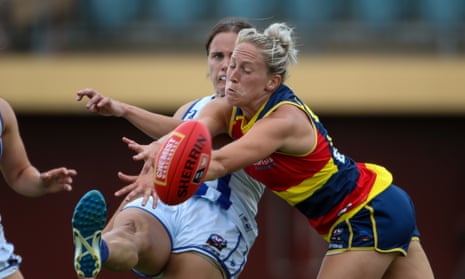In its inaugural 2017 season, the AFLW burst onto the national sporting stage on a warm Friday night in early February. In its sixth chapter it is squarely a summer offering from the AFL, an eventuality which has gathered mixed responses and equally varied outcomes.
From a player perspective, it is hard to know when the best time of year for the season would be. For such a physically taxing game, the hot weather alone is enough reason to question the December-March window. When the AFL explored India as a potential international venue for AFLM matches, one of the considerations was whether they could convince teams that the hot Indian weather was suitable for the game. Yet a similarly sweltering Australian summer is considered appropriate for AFLW players who, due to the part-time nature of their contracts, have far less time dedicated to conditioning, fitness and pre-season than their male counterparts.
This year’s season start was delayed due to Covid-19. Its initial schedule, commencing at the beginning of December 2021, would have allowed the players a mid-season break over Christmas and the new year before returning in January. While not the fault of the AFL, the postponed start has meant athletes were expected to train throughout the holiday period in preparation for a 7 January start. While this may make sense for full-time athletes from summer codes such as tennis or cricket, AFLW players are pausing day jobs to train and play at elite levels and then trying to resume their careers post-season.
It is possible we are seeing the effects of the huge physical demand on the playing group already. In two rounds season-ending injuries have sidelined star players. Some of this can be attributed to the lack of game time provided by the pre-season, with clubs playing only one practice match or none at all. A further delay to allow for extra practice matches, and a buffer time between the season proper and finals, could make for a safer competition. Again, however, this would rely on players being able to take even more time off work and study.
Many players would not begrudge a summer season as it allows them to play in pathway competitions for the remainder of the year. The current shortened season played in winter would see many athletes play less football overall, similarly under-serving their bodies, their talent, and the competition.
We often hear of the need for ‘clear air’ – a magical time in the sporting calendar where AFLW could be given its due attention by broadcasters and audiences alike. However, this has never actually happened. Initially squashed between the Australian Open and the beginning of the AFLM season, the W has never had a free go at audiences or broadcast. Even the clubs push out content daily on their AFLM teams’ pre-season happenings throughout the AFLW season. If the AFL wanted to prioritise ‘clear air’ for the AFLW, they would recognise it as a winter sport and make time to stage it alongside the already lengthy AFLM season.
The AFLW’s placement at the start of summer, combined with extra draft ceremonies after the AFLM season, all point to the AFL’s desire to ‘own’ the entire year. The AFL’s participation marketing push this year squarely exploits this idea with the tagline ‘taste summer footy’ paired with the image of an ice-cream cone in the shape of a football. The downside of this approach for the AFL, is the possibility of fan fatigue. Right now, the AFLW is competing with the Ashes, the Big Bash League and the Australian Open, to name a few.
As part of our discussion about the AFLW in summer, The Outer Sanctum polled listeners on the ideal time for the season to run. The response by fans was a clear preference for a winter season, with many assuming it would ultimately find its place there. No doubt, devoted fans will sweat it out in summer until then. What we cannot shake, however, is that the shorter season and part-time status of the players create the impression that the AFLW is still the summer sideshow to the main event in winter. That is, the men’s game. Were it to be played in winter, there is a risk the AFLM media coverage would drown out the AFLW. However given the way the AFL has built an ever-growing audience around the AFLW, perhaps a concerted marketing campaign by the AFL could circumvent this.
The ultimate solution for all would be a full 18-round season played in the winter and, one day, equal pay and full-time status. Time (and some major sponsors) will determine how long before we reach that horizon.
